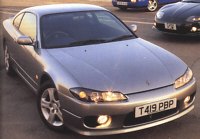 Strangely,
for nearly a decade we have forgotten what is "a beautiful Japanese
car".
Most of the great styling from Japanese car makers came in late '80s,
namely
the Nissan 300ZX, Mazda MX-5 and arguably the NSX. The Silvia of two
generations
ago (i.e., '88 model 200SX) is also a stunning looking car which
impressed
me so much. Its successor also stunned us by its look, just looking too
ugly ! I never like its boring, sedan-like appearance, which simply
can't
match with the uncompromising nature of a FR coupe. What's wrong with
Nissan's
studio which designed the '89 300ZX and the '88 200SX ? Did they go
crazy
? Strangely,
for nearly a decade we have forgotten what is "a beautiful Japanese
car".
Most of the great styling from Japanese car makers came in late '80s,
namely
the Nissan 300ZX, Mazda MX-5 and arguably the NSX. The Silvia of two
generations
ago (i.e., '88 model 200SX) is also a stunning looking car which
impressed
me so much. Its successor also stunned us by its look, just looking too
ugly ! I never like its boring, sedan-like appearance, which simply
can't
match with the uncompromising nature of a FR coupe. What's wrong with
Nissan's
studio which designed the '89 300ZX and the '88 200SX ? Did they go
crazy
?
When the new Silvia (S15) launched in Jan 99, the phrase "a beautiful Japanese car" flashed again in my brain. From the official pictures I saw a brave new design returning to aggression and innovation. Tell me when is your last time seeing an innovative new headlight design in a Japanese car ? Well, the Daihatsu Sirion might be, but we're talking about sports cars of course. Then, I'm afraid the answer is probably the "half-open eyes" of 300ZX of 1983. In the new car, the lamp cover is in an irregular shape just like the eyes of an ambitious young man. Not too aggressive, not too civilised either. Just perfect. In contrast, the rising edge at the side is probably copied from Ferrari 456GT. Overall speaking, the sleek, more sporty design is a big step forward from the outgoing car, although not necessarily an all-time great. Like the R34 Skyline, the new Silvia is smaller than the car it replaces in order to improve handling and reduce weight. Length, width and wheelbase have been cut by 75mm, 35mm and 10mm respectively. This immediately reduce the interior space, for example, the shoulder room is not as generous as before. The rear seats became limited to small children, especially when the transmission tunnel has already engaged a lot of space. The interior design tries to be classic. There is a stylish "Silvia" word in silver locates outside the glove box. In the middle, 3 circular air vents with chromed lining look like what you can find in any classic Ferrari. Basically the two-tone colour scheme is too grey, without luxurious leather trim or elegant aluminium decoration that you can find in European opponents. Just another boring Japanese cabin ? I won't say so, but at least it is too simple to me. Behind the three spoke steering wheel there is an instrument panel with 3 white dials, but where's the turbo pressure gauge ? Look at the odd little thing hanging down from the A-pillar ! This is another unique design of the new Silvia. The chassis structure is basically unchanged. Front and rear suspensions are still strut and multi-link respectively. Rear-wheel-drive is retained so to distinguish it from other rivals in handling. However, smaller dimensions improve chassis rigidity. An additional transverse brace reinforces the rear end structure. Below the distinctive headlamps there are 3 huge air intakes for cooling the brakes and the intercooler of the turbocharged engine. The power unit is still the 2-litre 16-valve inline-4. Normally aspirated version incorporates NVCS variable valve timing, output a modest 160ps. Turbocharged version, which is expected to be the best selling one, is benefited by the larger intercooler thus raise maximum power from 240ps to 250ps. Peak torque is 203 lbft. Fire the engine and you'll feel the vibration from the pedals and shifter. The unpleasant engine noise sings, "this is still the old school raw performance machine !" Four cylinders only, no balancer shafts, this is why you won't expect a beautiful soundtrack. Rough it may be, but it deliver a brutal performance. There is slightly turbo lag when the turbo starts boosting at 2500rpm. When maximum boost appears at 300rpm later, power surges and the beauty the Silvia becomes a beast. All things are under control, though. The engine spins strongly to 7200rpm rev limited without a cough. The 6-speed gearbox used in the "R Spec" is supplied by Toyota's subsidiary and shared with the Altezza (Lexus IS200) and Mazda MX-5. Nevertheless in the Silvia the gearshift quality is stiff, although short throw remains unchanged. The old school theory which sacrifice refinement for performance contributes to the remarkable 1250 kg kerb weight, hence a 0-60mph time in just 5.5 sec ! 0-100mph takes 14.2 sec, both are even faster than the Fiat Coupe turbo. Not only straight line, it also impresses car lovers with its handling. No matter how brilliant modern electronics is, the basic instinct of FR car is always unreplaceable - no torque steer no matter how hard it corners, no corrupted steering feel, easily controllable power oversteer, sharp turn-in ... it descends the likes of Fiat Coupe, Mitsubishi FTO and Alfa GTV into second division. Admittedly, it
doesn't control
as precise as BMW 328Ci, and you can say a few roadsters (e.g. MX-5,
S2000,
Elise, Boxster) are even better. However, among the affordable coupe
Silvia
is the only FR car remaining survival and it is also the most
satisfying
to enthusiastic drivers. |
| The above report was last updated on 8 Aug 99. All Rights Reserved. |